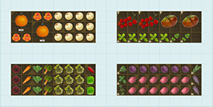Basics
- Ease of Growing
- Easy
- Grown as
- Annual
- Days to Maturity
- 48-50 (Spring/Summer)
- Growing Habit
- Bush
- Hardiness
- Tender
These tender annuals originated in the tropics and can't stand cold weather or frost.
- Crops
- Spring Transplant, Summer
- Growing Season
- Short, Long
- Cultivar Type
- -
- Growing Conditions
- Warm, Hot
These tender annuals originated in the tropics and love hot weather. They can't stand cold soil so don't plant them until it has warmed up (ideally to at least 70 degrees F). Use black plastic to warm the soil if necessary.
- Outdoor Growing Temp
- 60°F - 90°F
- Min Outdoor Soil Temp
- 70°F
Don't plant out until the soil temperature is close to 70 degrees.
- Start Indoors
- Yes
- Start Outdoors
- Yes
- Light
- Sun: min. 6 hours daily (Warm, Hot)
Full sun.
- Water
- High
The plants need an evenly moist soil for maximum productivity.
The best way to water Squash is with soaker hose, as wet foliage can easily lead to fungus diseases.
- Feeder
- Heavy
Summer Squash is a hungry and fast growing crop and needs a steady supply of nutrients.
- Suitability
- High heat, Needs lots of space
- Small Gardens?
- Yes
- Containers?
- Yes
Plant in a large pot with 12" depth. Be sure to provide the plants with ample fertilizer, like compost tea regularly. These hungry plants cannot search for their nutrient needs and will have to rely on you to provide them in order to produce decent size squash.
- Attracts beneficial insects?
- No
- Color
- Dark Green
- Fruit Size
- 4.0 - 5.0"
- Plant Height
- 24.0 - 36.0"
- Plant Diameter
- 24.0 - 36.0"
- Good Companions
- Radish, Bean, Scarlet Runner, Peanut, Cowpea, Bean, Edamame & Soybean, Corn, Bean, Bean, Lima, Onion
- Bad Companions
- Potato
- Hardiness Zone
- 3-11
- Disease Resistance
- -
- Taste Profile
Firm and meaty, holds structure well which makes it very versatile for a variety of cooking techniques.
- Rotation Group
- Fruits: Solanaceae + Cucurbits

